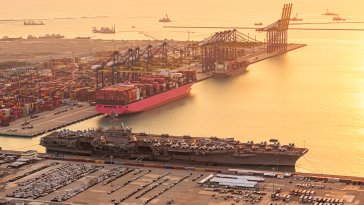
February Global Macro Monthly - Trade war
- 27 February 2025 (7 min read)
Global Macro Monthly Summary February 2025
By David Page, Head of Macro Research
Tariffs continue uneven roll-out
Any initial impression that Donald Trump’s second term would focus less on tariffs has been overturned; 25% tariffs on USMCA trade partners Canada and Mexico were deferred at the last minute for at least 30 days. It was not obvious whether this reflected concessions or Trump backed down. China saw a 10ppt rise on $525bn of goods. It retaliated, albeit in a limited fashion, raising tariffs of 10-15% on $14bn of goods. Trump has also scheduled 25% tariffs on all steel and aluminium imports from 12 March (again impacting Canada and Mexico), but there are doubts that these will materialise in full, or at all.
Trump’s initial targets appear curious but we believe simply reflect immediacy of delivery. The first tariffs were delivered through the International Emergency Economic Powers Act with steel and aluminium tariffs again following the 2018 section 232 national security measures. A deeper investigation, announced as the America First Trade Policy, is due to report on 1 April. Trump has now added to this the goal of reciprocal tariffs to be assessed around the same time. This is likely to provide justification for further executive tariff orders. We expect additional tariffs to be announced on the Eurozone, China and other economies in Q2.
Revenue raising appears the administration’s key motivation, to help package the case for tax cuts – including extending Trump’s first term tax cuts and new corporate tax and social security cuts – to Republican hawks. This desire is likely to see tariffs broaden. The impact of renewed increases remains to be seen. After the China tariff hikes the US effective tariff rate has increased by around 1.5ppt. Our baseline scenario envisaged a total rise of around 5ppt, phased in over the rest of this year. We see these as weighing on growth into year-end and lifting CPI inflation to around 3% over the next two years.
Military mercantilism?
Trump has started a process to stop the fighting in Ukraine. Contrary to more supportive comments towards Ukraine recently, Trump’s initial discussions have been conducted with Russia and appeared to concede key issues, including NATO membership. Trump also suggested Ukraine started the war and called Ukrainian President Volodymyr Zelensky a “dictator”. As elsewhere, the motive and direction of US policy are unclear, with suggestions that policy goals include negotiations of a US-Ukrainian mineral rights access deal. Markets have mainly focused on the immediate implications for energy, assuming reduced Russian sanctions as part of any deal would boost oil and gas supply. The impact on oil prices has been modest (Brent down less than 10%), but European gas prices – highly elevated into this year – have fallen by more than 20%. We note though that counting on increased natural gas supply to Europe appears to run contrary to Trump’s demand for Europeans to buy more US Liquified natural gas (NLG).
Beyond excluding Ukraine from negotiations, European powers have also been left out of the process. This poses several questions over the US’s ongoing relationship with Europe, beyond the risks of repeating policies of appeasement towards an aggressor state - all too obvious to Europeans. The combination of US trade policy pressure and an apparent material shift in strategic alliance leaves European countries reviewing future defence programmes. Most NATO countries had commitments to raise defence spending over coming years, but recent developments may accelerate this.
Moreover, the US stance may also reflect recent European political weakness. The recent German elections may begin to address this, after returning the CDU/CSU partnership led by Friedrich Merz to the Chancellery, in an expected coalition with the SPD, which he suggested could materialise as soon as in two months. This may galvanise German public spending, despite risks from extreme parties blocking progress. For full details see our preview of the German elections1 . More fundamentally he has discussed independence from the US. However, the rest of Europe remains politically fragile. France’s latest Prime Minister François Bayrou managed to stave off a vote of no confidence having passed a more modest budget aiming to reduce France’s deficit to an expected 5.4% from 6.1% in 2024. Although remaining in office is the lowest bar for any government, it suggests some stability for the coming months. Yet in Italy, arguably Europe’s strongest government, Prime Minister Giorgia Meloni – a frequent strong and vocal backer of Ukraine – only attended what has been an annual show of G7 commitment to Ukraine by video conference, as did UK Prime Minister Keir Starmer.
- Q2FiYXUsIEYuLCDigJw8YSBocmVmPSJodHRwczovL3d3dy5heGEtaW0uY29tL2ludmVzdG1lbnQtaW5zdGl0dXRlL21hcmtldC12aWV3cy9tYWNyb2Vjb25vbWljcy9nZXJtYW4tZWxlY3Rpb24tcHJldmlldy1haW1pbmctZ3JhbmQtcmVzZXQiPkdlcm1hbiBlbGVjdGlvbiBwcmV2aWV3OiBBaW1pbmcgYXQgYSBncmFuZCByZXNldDwvYT7igJ0sIEFYQSBJTSBNYWNybyBSZXNlYXJjaCwgMTMgRmVicnVhcnkgMjAyNQ==
Related publications
Disclaimer
This website is published by AXA Investment Managers Australia Ltd (ABN 47 107 346 841 AFSL 273320) (“AXA IM Australia”) and is intended only for professional investors, sophisticated investors and wholesale clients as defined in the Corporations Act 2001 (Cth).
This publication is for informational purposes only and does not constitute investment research or financial analysis relating to transactions in financial instruments, nor does it constitute on the part of AXA Investment Managers or its affiliated companies an offer to buy or sell any investments, products or services, and should not be considered as solicitation or investment, legal or tax advice, a recommendation for an investment strategy or a personalized recommendation to buy or sell securities.
Market commentary on the website has been prepared for general informational purposes by the authors, who are part of AXA Investment Managers. This market commentary reflects the views of the authors, and statements in it may differ from the views of others in AXA Investment Managers.
Due to its simplification, this publication is partial and opinions, estimates and forecasts herein are subjective and subject to change without notice. There is no guarantee forecasts made will come to pass. Data, figures, declarations, analysis, predictions and other information in this publication is provided based on our state of knowledge at the time of creation of this publication. Whilst every care is taken, no representation or warranty (including liability towards third parties), express or implied, is made as to the accuracy, reliability or completeness of the information contained herein. Reliance upon information in this material is at the sole discretion of the recipient. This material does not contain sufficient information to support an investment decision.
All investment involves risk , including the loss of capital. The value of investments and the income from them can fluctuate and investors may not get back the amount originally invested.




